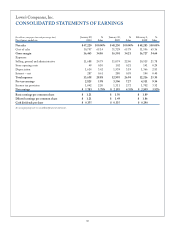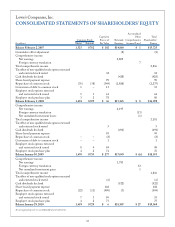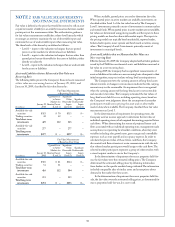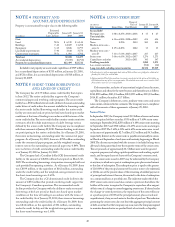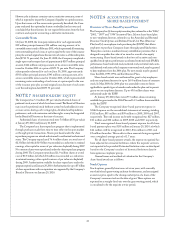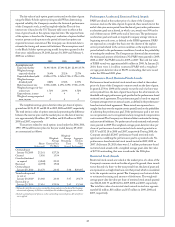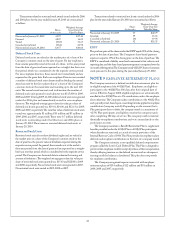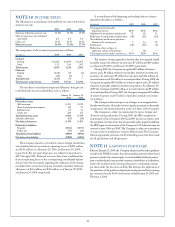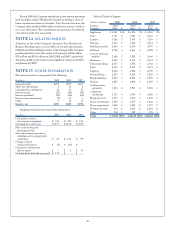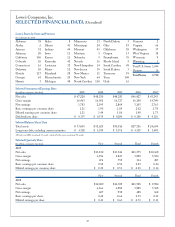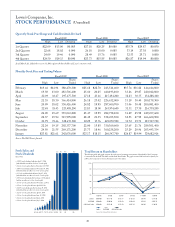Lowe's 2009 Annual Report Download - page 41
Download and view the complete annual report
Please find page 41 of the 2009 Lowe's annual report below. You can navigate through the pages in the report by either clicking on the pages listed below, or by using the keyword search tool below to find specific information within the annual report.
39
e following table presents the Company’s non-financial assets
required to be measured at fair value on a non-recurring basis and any
resulting realized losses included in earnings. Because long-lived assets
are not measured at fair value on a recurring basis, certain carrying
amounts and fair value measurements included in the table may reflect
values at earlier measurement dates and may no longer represent the
carrying amounts and fair values at January 29, 2010.
Fair Value Measurements –
Non-recurring Basis
Operating Stores Excess Properties
Long-lived Long-lived Long-lived
Assets Assets Assets
(In millions)
Total Held-for-Use Held-for-Use Held-for-Sale
For the year ended
January 29, 2010:
Fair value
measurements $ 105 $ 6 $ 74 $ 25
Previous carrying
amounts 219 59 114 46
Impairment losses $(114) $(53) $ (40) $(21)
e Company’s financial instruments not measured at fair value
on a recurring basis include cash and cash equivalents, accounts
receivable, short-term borrowings, accounts payable, accrued liabilities
and long-term debt and are reflected in the financial statements at
cost. With the exception of long-term debt, cost approximates fair
value for these items due to their short-term nature. Estimated fair values
for long-term debt have been determined using available market
information, including reported trades, benchmark yields and broker-
dealer quotes.
Carrying amounts and the related estimated fair value of the
Company’s long-term debt, excluding capital leases and other,
are as follows:
January 29, 2010 January 30, 2009
Carrying Fair Carrying Fair
(In millions) Amount Value Amount Value
Long-term debt
(excluding capital
leases and other) $4,737 $5,127 $4,726 $4,653
NOTE 3 INVESTMENTS
e amortized costs, gross unrealized holding gains and losses, and fair
values of the Company’s investment securities classified as available-
for-sale at January 29, 2010, and January 30, 2009, are as follows:
January 29, 2010
Gross Gross
Type Amortized Unrealized Unrealized Fair
(In millions) Costs Gains Losses Value
Municipal bonds $301 $2 $ – $303
Money market funds 68 – – 68
Tax-exempt commercial
paper 10 – – 10
Certificates of deposit 2 – – 2
Classified as short-term 381 2 – 383
Municipal bonds 275 2 – 277
Classified as long-term 275 2 – 277
Total $656 $4 $ – $660
January 30, 2009
Gross Gross
Type Amortized Unrealized Unrealized Fair
(In millions) Costs Gains Losses Value
Municipal bonds $296 $3 $ – $299
Money market funds 79 – – 79
Tax-exempt commercial
paper 5 – – 5
Certificates of deposit 2 – – 2
Classified as short-term 382 3 – 385
Municipal bonds 248 5 – 253
Classified as long-term 248 5 – 253
Total $630 $8 $ – $638
e proceeds from sales of available-for-sale securities were
$1.2 billion, $1.0 billion and $1.2 billion for 2009, 2008 and 2007,
respectively. Gross realized gains and losses on the sale of available-
for-sale securities were not significant for any of the periods presented.
e municipal bonds classified as long-term at January 29, 2010,
will mature in one to 38 years, based on stated maturity dates.
Effective February 2, 2008, the Company adopted authoritative
guidance issued by the FASB that provides entities with an option to
measure many financial instruments and certain other items at fair
value. Under this guidance, unrealized gains and losses on items for
which the fair value option has been elected are reported in earnings
at each reporting period. Upon adoption, the Company elected the
fair value option for certain pre-existing investments, which had a
carrying value of $42 million and were accounted for as available-for-
sale securities included in long-term investments in the consolidated
balance sheet at February 2, 2008. Subsequent to the election, these
investments are reported as trading securities, which are included in
short-term investments, and were $42 million and $31 million at
January 29, 2010 and January 30, 2009, respectively. For the year ended
January 29, 2010, net unrealized gains for trading securities totaled
$7 million. For the year ended January 30, 2009, net unrealized losses
for trading securities totaled $14 million. Unrealized gains and losses
on trading securities were included in SG&A expense. Cash flows
from purchases, sales and maturities of trading securities continue to
be included in cash flows from investing activities in the consolidated
statements of cash flows because the nature and purpose for which
the securities were acquired has not changed as a result of the adoption
of this guidance. e adoption of this guidance did not have a material
impact on the Company’s consolidated financial statements.
Short-term and long-term investments include restricted balances
pledged as collateral for letters of credit for the Company’s extended
warranty program and for a portion of the Company’s casualty insurance
and Installed Sales program liabilities. Restricted balances included
in short-term investments were $186 million at January 29, 2010
and $214 million at January 30, 2009. Restricted balances included
in long-term investments were $202 million at January 29, 2010 and
$143 million at January 30, 2009.



